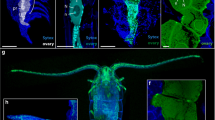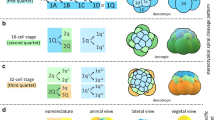Summary
Films of cleaving embryos of the axolotl,Ambystoma mexicanum, taken by the “double camera” technique, were used in order to arrive at a more detailed staging based on quantitative criteria. Drawings were made of the animal hemispheres just prior to the start of each cleavage cycle from the 6th to the 15th cleavage. The number of cells intersected either by the (apparent) “egg diameter” (up to the 10th cleavage) or by “half the diameter” (from the 10th cleavage onwards) was determined. The cell numbers for each cleavage cycle did not overlap with those of the previous or succeeding cycles. On the basis of these cell numbers, in place of the four Harrison stages 6–9, 10 successive stages were established each of which corresponds to one cleavage cycle.
Similar content being viewed by others
References
Grunz, H.: Experimentelle Untersuchungen über die Kompetenzverhältnisse früher Entwicklungsstadien des Amphibien-Ektioderms. Wilhelm Roux' Archiv160, 344–374 (1968)
Hara, K.: “Double camera” time-lapse micro-cinematography; simultaneous filming of both poles of the amphibian egg. Mikroskopie26, 181–184 (1970)
Hara, K.: The cleavage pattern of the axolotl egg studied by cinematography and cell counting. Wilhelm Roux's Archives181, 73–87 (1977)
Harrison, R.G.: Organization and development of the embryo (Wilens, S., ed.). New Haven: Yale Univ. Press 1969
Nakamura, O.: How does the organizer itself get organized? Japan. J. exp. Morph.21, 256–275 (1967)
Nakamura, O., Takasaki, H.: Further studies on the differentiation capacity of the dorsal marginal zone in the morula ofTriturus pyrrhogaster. Proc. Japan Acad.46, 546–551 (1970)
Nakatsuji, N.: Studies on the gastrulation of amphibian embryos: Numerical criteria for stage determination during blastulation and gastrulation ofXenopus laevis. Develop. Growth Diff.16, 257–265 (1974)
Nieuwkoop, P.D., Faber, J., eds.: Normal table ofXenopus laevis (Daudin). Amsterdam: North-Holland 1956
Schreckenberg, G.M., Jacobson, A.G.: Normal stages of development of the axolotl,Ambystoma mexicanum. Develop. Biol.42, 391–400 (1975)
Signoret, J., Lefresne, J.: Contribution a l'étude de la segmentation de l'oeuf d'axolotl: I—Définition de la transition blastuléenne. Annal. Embryol. Morphogen.4, 113–123 (1971)
Sirakami, K.-I.: Cyto-embryology of amphibians. In: Studies in developmental physiology (Dan, K., Yamada, T., eds.), pp. 221–264. Tokyo: Baifu-Kan 1958 (in Japanese)
Twitty, V.C., Bodenstein, D.:Triturus torosus: The California salamander. In: Experimental embryology (Rugh, R., ed.), p. 90. Minneapolis: Burgess 1962
Author information
Authors and Affiliations
Rights and permissions
About this article
Cite this article
Hara, K., Boterenbrood, E.C. Refinement of Harrison's normal table for the morula and blastula of the axolotl. Wilhelm Roux' Archiv 181, 89–93 (1977). https://doi.org/10.1007/BF00857270
Received:
Published:
Issue Date:
DOI: https://doi.org/10.1007/BF00857270




